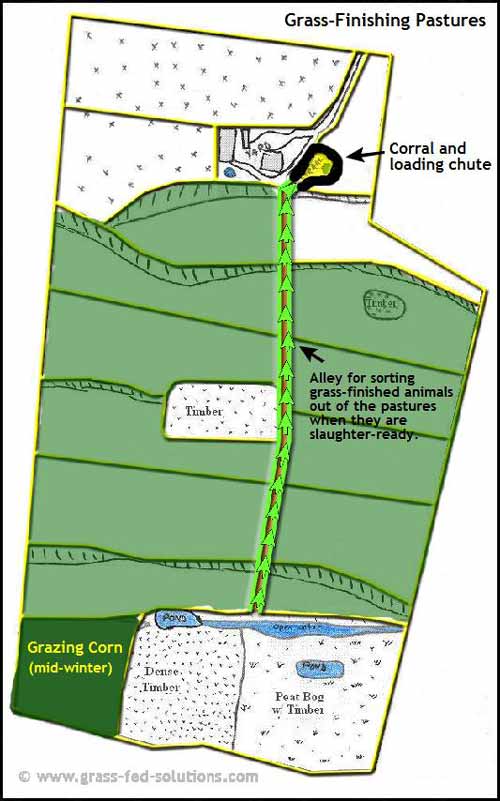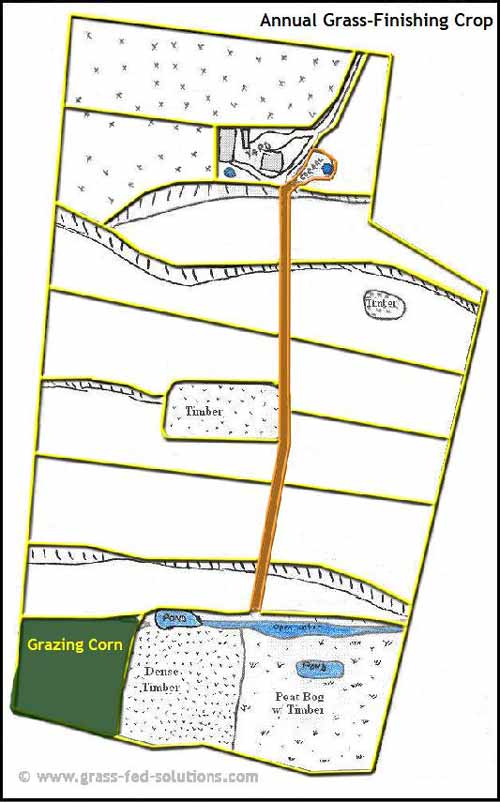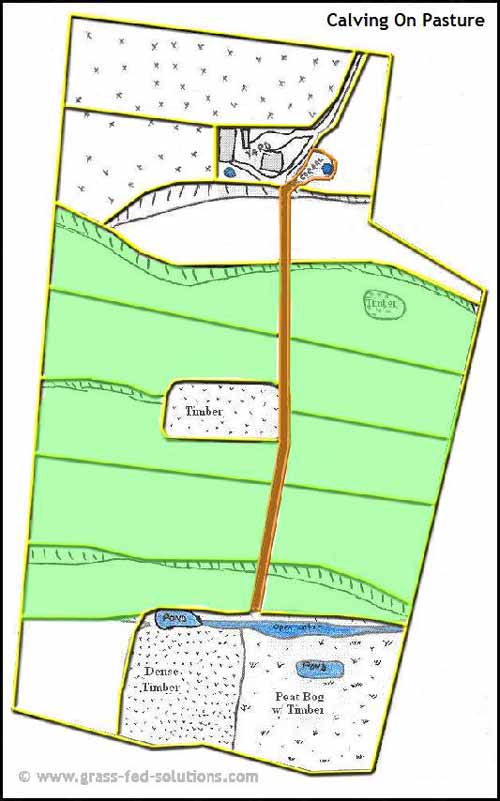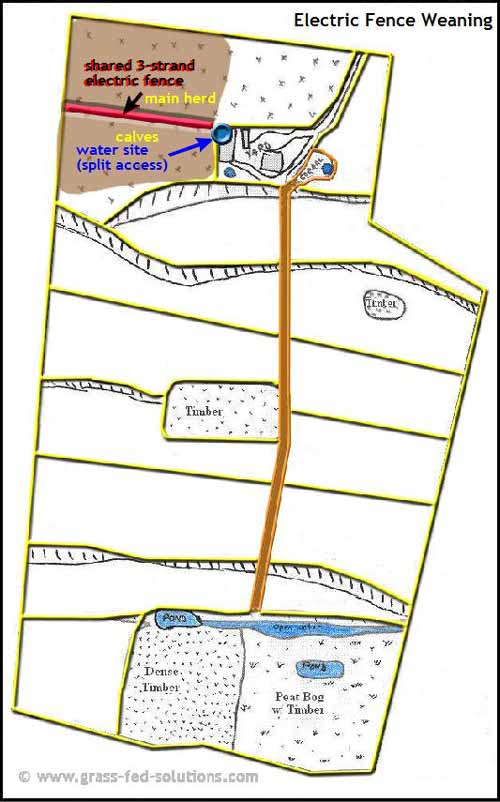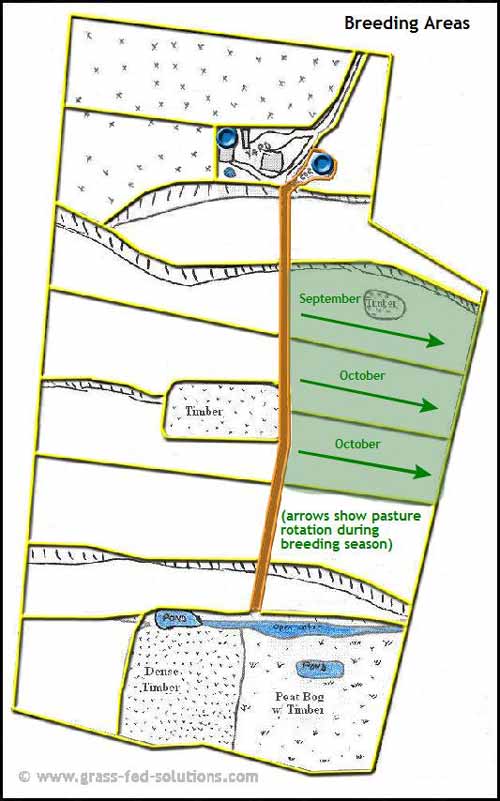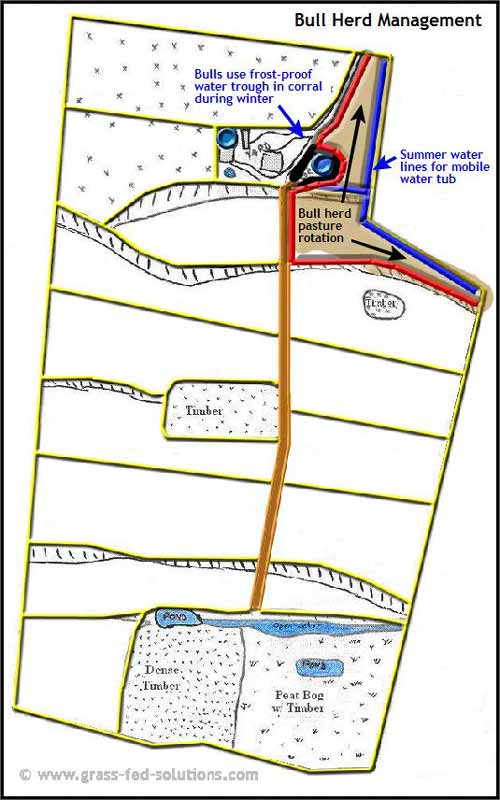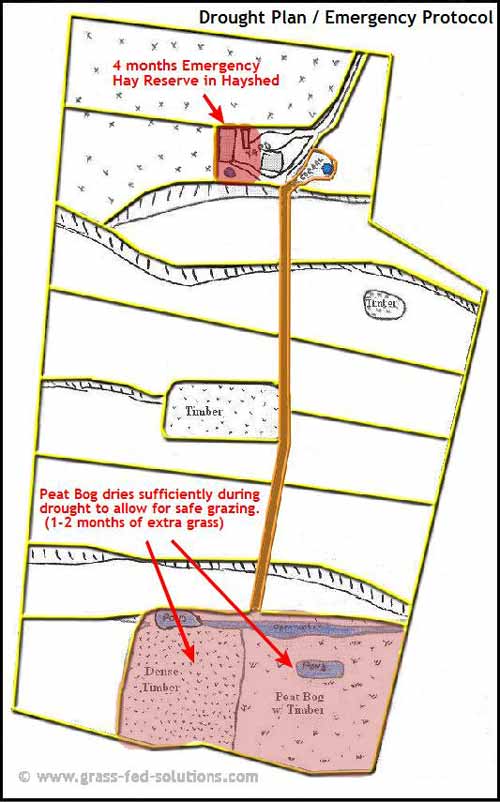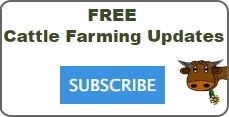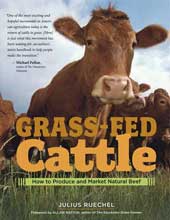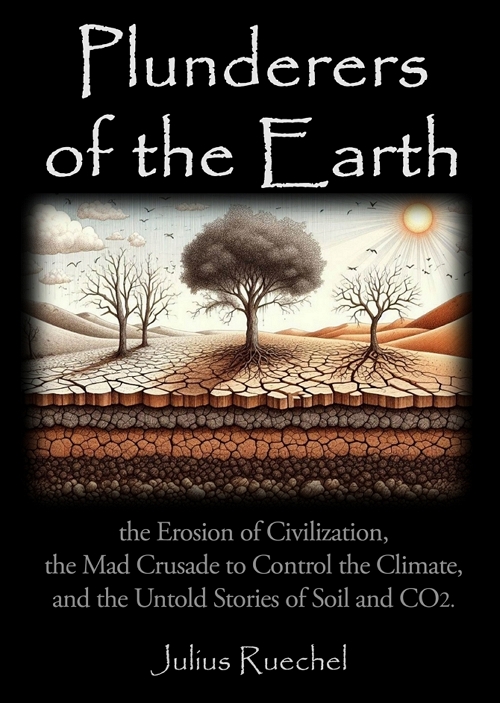Example Cattle Farm Plan:
Part III: Calving, Weaning, Breeding, Grass Finishing, Treatment Protocols, and Other Special Considerations
The first two parts of the Example Cattle Farm Plan showed how the summer and the winter pasture rotations are organized and how cattle water is supplied both during the growing season and during the winter when the ground is frozen.
In this third and final part of the example farm plan, I will show you the plans for all the special considerations that make up the grass fed beef cattle production year: grass-finishing, calving, weaning, breeding, cattle health protocols, bull herd management, and the drought/emergency farm plans.
While there is a great deal of overlap between many of the maps shown on this page and the summer and winter pasture rotations shown in the first two parts of this article, the accompanying explanations shown with the maps below highlight how important it is to plan each component of your grass-fed beef farm separately to ensure that each component meshes seamlessly with the rest.
For example, while the grass-finishing maps below depend on the summer pasture rotation maps shown in Part I, the grass-finishing plan includes quite a few additional details to make the summer pasture rotation suitable for grass-finishing. This includes paying special attention to the plant species used for grass-finishing as well as pre-planning the strategy for sorting grass finished beef animals out of the herd as they reach their target market weights without the sorting leading to a disruption of the rest of the pasture rotation.
The Grass-Finishing Plan
The green areas in this first map show the pastures that will be used for grass-finishing. (The dark green area labeled 'Grazing Corn' will be discussed separately below.
In this farm plan, given the small herd size, the grass-finishing animals will be kept as a combined herd together with the cow/calf pairs and yearlings. While they share the same space, there are a few extra considerations to ensure maximum weight gains on pasture...
The green areas on the map have been over-seeded to increase the diversity of grass and legume species in the pasture. Increasing the plant diversity (and including legumes like alfalfa or milk vetch) ensures that the cattle nutrition remains as consistent as possible throughout the entire growing season and reduces the risk of having all the pastures go to seed at the same time. Increasing plant diversity ensures that you maximize nutritional quality while spreading grass growth throughout the entire growing season (rather than maximizing pasture yield on a single harvest date, as is typical if you are growing hay and other forage crops that are mechanically harvested).
The pasture mix includes plant species that will retain their nutritional value deep into the winter (such as Altai Wild Rye), when many of the other pasture species that flourished during the summer are more susceptible to nutrient leaching. Pages 62-64 of Grass-Fed Cattle discusses how to choose the best plants for your pasture smorgasbord and explains several techniques for over-seeding and diversifying the plant species in your pastures without having to plow up and reseed pastures from scratch.
Producing grass finished beef is not just about fattening the cattle according to the Seven Rules of Good Beef. Your farm plan also needs to include a strategy for sorting grass finished beef cattle out of the herd without disrupting the pasture rotation and without having to round up and bring the entire herd back to the corral. This is especially important if you harvest grass-finished cattle regularly throughout the summer, fall, and early winter instead of only slaughtering at a single date in the fall.
The cattle alley leading back to the corral (highlighted in neon green line on the Grass-Finishing map above) is a critical component of the grass-finishing strategy because it links every permanent electric fence corridor back to the corral so grass-finished cattle can easily be sorted out of the main herd. (Daily pasture rotations are a small area, which makes it very easy to sort cattle out of the herd with minimal disruption. Large multi-day grazing slices are too large for easy sorting out on pasture.)
Temporary portable electric fence alleys are set up to link the current daily pasture slice to the cattle alley so that sorted cattle are always easily contained. Grass-finished cattle are never sorted and herded back to the corral alone - a small group of cattle containing the target animals is split from the main herd to keep everyone calm. A final sort is performed in the corral and then the animals that were not needed can be quietly walked back to the main herd via the same cattle alley.
You can learn more about grass finishing in the Grass Finishing section of this website and in the 'Grass Finished Beef' chapter of Grass-Fed Cattle.
Annual Grass Finishing Crop for Extending the Grass Finishing Season
The dark green area in the map on the left shows a field that has been specifically set aside for growing annual grazing crops that will help extend the length of the grass-finishing season during the winter months. This farm has chosen grazing corn for this purpose, though there are a wide range of other annual crops that are suitable for extending the grass-finishing season.
Planting annual crops for winter grazing and/or grass-finishing (such as grazing corn or Sorghum-Sudan grass) considerably raises the cost of grass fed beef production because of the tillage and seed costs involved, however, it should be a tool that you are aware of for your grass fed beef production program - in some cases it may fit into your farm plan, such as if you need to extend your grass finishing season to secure an important contract with a beef buyer that is unable to buy frozen beef during the winter months. However, in most cases, careful preparation of perennial pasture crops is by far the more cost-effective strategy to extend your grass-finishing season.
The grazing corn used by the example grass-fed beef farm was added to their winter grazing arsenal because the tall corn plants are able to withstand even deep snow covers. Grazing corn requires choosing a late-maturing corn variety that is then planted very late so that the corn does NOT form cobs before being killed by frost in the fall. This is important - until corn forms seed cobs it is a grass, but once cobs form it becomes a grain crop and your beef will not technically be grass-finished anymore. Seed formation is detrimental for other reasons too. If cobs are formed, the plant will drain nutrients from the leaves, reducing the nutrient content of the green leafy parts of the plant. And corn cobs concentrate the plant sugars in the kernels. These high sugar concentrations will mold during the wet late-fall weather. Some of these molds can be toxic and can cause abortions in your brood cows. Thus, managing your grazing corn to prevent cob formation in the fall is extremely important to your ability to use it for winter grazing. Some grass-fed producers will graze their annual grazing corn crop mid-way through the summer to knock back the plant growth and prevent cob formation.
Reminder
One of my favorite late-fall or early winter grass finishing crops that does not require annual tillage is to graze alfalfa after it has been killed by frost. This high-octane crop is an excellent grass-finishing pasture that will extend cattle weight gains deep into the winter if managed correctly.
The grazing corn does not need to be planted in the traditional wide-spaced corn rows used for harvesting corn for silage. Since it will be grazed, it can also be planted with a conventional grain seed drill to create a more even soil cover. It can also be over-seeded with another cover crop to stabilize the soils during grazing, particularly if the grazing corn is grazed part-way through the summer. When grazing it during the winter, use your ATV to knock down paths for your portable electric cross fences prior to grazing.
The example farm plan has set aside this grazing corn crop strictly for their grass finished beef animals. As pasture quality deteriorates in the main pastures in December, limiting further cattle weight gains, the grass-finishing animals are sorted out of the main herd and grazed in the grazing corn until the corn is used up. At that point the grass-finishing animals are rejoined with the main cattle herd and the grass finishing season comes to an end.
Calving On Pasture
Calving on pasture in summer is very different from the calving season used by most conventional cattle ranches because the calving season occurs right in the midst of the daily summer pasture rotation.
The green areas on the map on the left show which pastures will be part of the pasture rotation during the calving season. Any pastures with heavy timber have been excluded to ensure that calves do not get left behind during pasture moves. Follow the link to learn about the single-wire electric fence divisions, daily pasture moves, and management routine required for managing a successful calving program on pasture.
Electric Fence Weaning
Electric fence weaning is the easiest way to wean cattle and almost completely eliminates the stress normally associated with weaning.
Split the cow and calf herds onto opposite sides of a 3-strand electric fence, shown as the red line dividing the two brown weaning pastures in the image on the left. Continue the pasture rotation so that cows and calves are directly adjacent to one another in adjacent pastures separated only by the 3-strand electric fence. This allows the cows and calves to have contact with one another (sight, sound, and smell) but prevents the calves from suckling. This strategy prevents most of the commotion normally associated with weaning because the cows and calves do not experience the separation anxiety that causes all the stress during traditional weaning programs. The cows and calves will pace the fence, but because they can find each other, they won't break through. Within a day or two they will already begin grazing further and further from the fence. Within a week, they will have lost interest in one another and can be moved out of sight of one another without further stress.
This weaning strategy will significantly reduce your cattle health issues during weaning because there is so much less stress involved for both cow and calf.
Weaning is timed so that weaning occurs AFTER the worst of the spring mud season when pastures have already dried up, the weather has begun to warm, and there is already a hint of green grass in the pastures for the calves to nibble on. This still gives the cows 1-2 months to prepare for calving without needing to support the previous year's calf. You can learn more about how to use the timing of your weaning program to manage cattle nutrition during the winter by reading these cattle nutrition tips.
Breeding Areas
Cattle breeding in this example farm plan will occur in September and October in the shaded pastures shown on the map to the left. These pastures are ideal for cattle breeding because these pastures all have level ground to prevent injuries to the bulls during breeding. Furthermore, there are no visual obstacles (like heavy timber) in the breeding pastures so a smaller number of bulls can cover a larger number of cows (cow/bull ratio).
The breeding season is discussed at length, including the best cow/bull ratio for your cattle breeding program and how to pick the best heifers and bulls for your cattle herd in the 'Genetics and Breeding' chapter of Grass-Fed Cattle.
Sick Animal Treatment Protocol
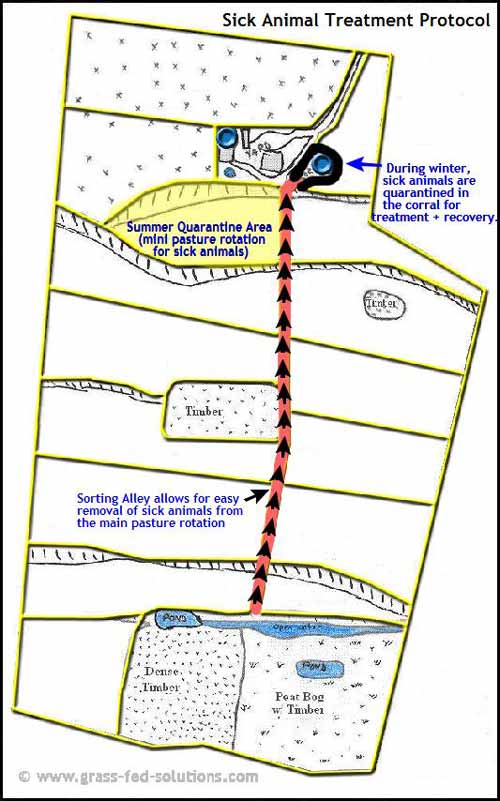 Use this map layer to plan your sick animal treatment protocol - how to efficiently remove sick animals from pasture for treatment and where to quarantine sick animals.
Use this map layer to plan your sick animal treatment protocol - how to efficiently remove sick animals from pasture for treatment and where to quarantine sick animals.Cattle health involves a great deal of preventative measures, ruthless culling practices, and a proactive sick animal treatment protocol that includes a quarantine area to prevent the spread of disease. The 'Pests, Parasites, and Diseases' chapter of Grass-Fed Cattle discusses both preventative measures and treatment protocols for a number of common cattle diseases.
The map on the left shows the pasture (yellow area) that is used as the quarantine pasture for animals getting treated for infectious diseases, like pink eye or pneumonia, during the summer grazing season.
The cattle alley (in orange) is an integral part of the farm's treatment protocol because it allows sick animals to easily be herded back to the corral using the same sorting practices discussed in the grass-finishing section above. An early response is often half the battle in treating diseases and preventing contagion. Having a pre-planned strategy in your farm plan to get sick cattle back to the corral for treatment from every single part of the pasture rotation, without stressful rodeo-like cattle chases, is integral to your success as a grass fed beef rancher.
Bull Herd Management
The bull herd maintains its own separate pasture rotation outside of the cattle breeding season. The blue lines show the polyethylene pipe network that supplies the mobile cattle water tub used for the bull herd pasture rotation in the summer. In winter they must travel back to the corral to access the frost-proof cattle waterer for their drinking water needs.
The red line shows the dividing fence between the bull herd pastures and the pastures used by the remainder of the cattle herd. This dividing fence should be 2 or 3 strand electric fence to discourage the bulls from jumping over the fence to visit the cows. Furthermore, the bulls and cows should never be allowed to share the same fence-line. If they do, it doesn't matter how many wires you put up, the bulls will break through for a visit...
While a daily pasture rotation is ideal for the bull herd, many people with small cattle herds find that it isn't worth maintaining a separate daily rotational grazing program for just 2 or 3 bulls and choose to use less frequent pasture moves and feed their bulls with hay during the winter.
Drought / Emergency Protocols
There is a saying that "the average year only comes around once every ten years or so, on average." The point is, prepare for the unexpected.
The length of the winter grazing season depends on (1) the skill of the farmer to create high quality winter pastures suitable for winter grazing, (2) implementing a good nutritional supplement program to support the rotational grazing program throughout the winter season, and (3) developing the skills and experience to extend their winter grazing season through the entire winter. While the experience level of the example grass fed beef farm plan featured in this article allows for year-round grazing, this farm still maintains a permanent hay reserve (small red shaded area) sufficient to feed the entire cattle herd for four months in case of a particularly severe winter, a miscalculation on the part of the farmer, or a severe drought during the growing season that compromises how much grass is left over for the winter pasture rotation.
This emergency hay reserve is a permanent feature on the farm. If not used it is constantly being refreshed by selling hay in years when hay prices are high, buying hay when hay prices are low, or by hiring the services of a custom haying crew to make hay from excess pasture growth during years with unusually high pasture yields.
The hay reserve is a key part of the drought plan. Feeding a little hay to slow down the pasture rotation to prevent overgrazing the pastures allows you to maximize grass growth rates, as is explained in this article about the summer pasture rotation. Preventing overgrazing during a drought is key to avoiding excessive moisture losses from your pasture soils and ensures that pastures recover quickly at the end of a drought. The emergency hay reserve is therefore a life-line during adverse weather, as well as an insurance policy and drought management strategy.
The hay reserve in your farm plan also provides an important cushion to allow farmers to safely learn how to extend their winter grazing program through the entire winter season without risking the health and well being of their cattle. The hay reserve provides the necessary buffer if a farmer miscalculates the amount of grass in their winter pasture rotation or if a farmer's ambitions exceed their experiences with winter grazing strategies. First-time winter grazing programs should maintain a large enough emergency hay reserve to last the entire winter grazing season.
Winter grazing is all about learning how to extend the grazing season a little longer every year until your experience over many years finally allows you to graze year-round. Year-round grazing in seasonal climates is not something that you can expect to accomplish the first year; your hay reserve helps underwrite your learning process to keep your cattle and your finances healthy as you gain experience.
The example grass-fed beef farm plan is fortunate to have a second drought reserve (shown as the large red shaded area at the bottom of the map). This bog area is too wet during average years for safe grazing during the summer and is normally only grazed during the winter after the ground freezes. But during exceptionally dry years the soils dry out sufficiently for safe grazing, adding as much as 1 to 2 months of extra pasture to the pasture rotation. This provides an important relief valve during drought years to ensure that the grass stubble left behind during the summer pasture rotation remains tall enough to provide shade for the soil and minimize soil moisture evaporation.
The 'Planning for Drought' chapter of Grass-Fed Cattle provides more comprehensive information on how to include drought planning in your farm plan, including your pre-planned culling protocol which identifies which categories of animals to cull first to allow you to drastically reduce your herd size at the onset of a severe drought without compromising your herd's future productivity once the drought ends. Surviving a drought is as much about how quickly you can recover following the drought as it is about surviving the drought conditions themselves.
The example farm plan in this article showed how all the principles and practical 'how-to' information described in Grass-Fed Cattle: How to Produce and Market Natural Beef can be boiled down to a very simple farm plan. Keep your farm plan simple. By the time you are done designing your farm maps, pasture rotation, and grass-fed beef business plan, you should be able to give your farm plan to anyone familiar with basic grass fed beef production principles and they should be able to successfully manage your farm without you having to say a word.
Related Articles:
(Disclosure: I get commissions for purchases made using Amazon links in my post.) And when you're ready to start planning your cattle farm, check out my book: Grass-Fed Cattle: How to Produce and Market Natural Beef. Use the links below to explore my book and read reviews on Amazon: 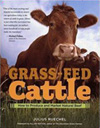
|

